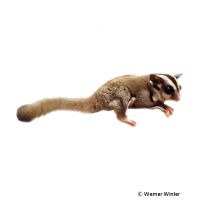Sugar Glider (Petaurus breviceps)
| Sugar Glider Petaurus breviceps | |
|---|---|
| Name | Sugar Glider |
| Name Lat. | Petaurus breviceps |
| Family | Petaurids |
| Family lat. | Petauridae |
| Order | Diprotodonts |
| Order lat. | Diprotodontia |
| Origin | Indonesia, Australia |
| Climate | Subtropical - tropical |
| Habitat | Forest |
| Diet | Insects, fruits, seeds |
| Behavior | Nocturnal, territorial |
| Keeping | Pair, group |
| Care Level | Experts only |
| Life Span | 8-12 years |
| Protection | No |
| Metric Units | |
| Size | 12-20 cm |
| Temperature | Room temperature |
| Housing | A: 2 m² / H: 2 m |
| US Units | |
| Size | 4.7"-7.9" |
| Temperature | Room temperature |
| Housing | 20 ft² / 80" hight |
Distribution and habitat
The natural range of the nocturnal Sugar Glider extends over northern and eastern Australia, Papua New Tunisia and some Indonesian islands (Moluccas, Salawati, etc). They inhabit tree cavities of primary and secondary forests up to more than 2800 m and are also found as cultural successors in plantations and garden landscapes.
Maintenance
Minimum dimensions for the enclosure:
| 1-5 animals | area: 2 m² | height: 2 m |
For each additional animal, the area and room dimensions must be increased by approx. 10 %.
The enclosure must be equipped with sufficient sleeping caves and hiding places (e.g. cork tubes, exotic nesting baskets, grass or hay nests) as well as with securely anchored branch and climbing material made of wood and ropes and structured in such a way that gliding flight of the animals is made possible. In addition, abundant leaves and foliage should be offered for nest building. The health-safe, absorbent bedding (e.g. small animal litter, hemp litter, cotton litter, etc.) must always be kept clean and dry. Nail material must be available at all times. A natural day-night rhythm must be ensured. Temperatures must not fall below 18 °C
Diet
They are mixed feeders, eating a predominantly vegetarian diet but also requiring animal protein. Accordingly, the species-specific food supply consists of fruit, also as fruit pulp (e.g. apples, pears, berries, grapes, etc.), nectar, a grain mixture, available in specialty stores as "chipmunk food mixture" and some animal protein (e.g. lean, boiled meat, hard-boiled egg, flour beetle larvae, zophobas). To supply minerals, a mineral stone and salt lick should not be missing. As a treat, individually varying dried fruits, such as raisins, honey, rose hips (high vitamin C content) and nuts can be fed occasionally. Regular addition of calcium is important. Drinking water must always be available in hanging bottles or in stable, open containers. Water and food containers must be arranged so that they cannot become soiled. Water and feed must be offered fresh daily.
A regular and varied diet promotes health and prevents deficiency symptoms.
Behaviour and compatibility
The social animals should be kept in family groups. Each group defends its territory and marks it with its own strong-smelling secretion. At the first signs of incompatibility, the animals should be separated immediately.
Reproduction and breeding
Males have a scent or marking gland on the forehead, which can be seen as a bald spot on the head. The females have a prey-like pouch.
The gestation period is 15-17 days. A litter usually consists of 1-2 young. They climb into the pouch blind and underdeveloped, suckle on one of the 2 teats, and remain in the pouch for up to 70 days. Young cling to the fur of the female and are carried by them. At 4 months of age, they begin to become independent. Sexual maturity begins at 8-15 months in the female and 12 months in the male. Life expectancy is usually 8-12 years.
Important
Sugar Gliders have a hairy flying membrane between their extremities that helps them glide from branch to branch in long leaps, with the tail acting as a control
The fourth toe on the forelegs is extended with a sharp claw, which the animal uses to retrieve insects from tree bark. They must not be grabbed or pulled by the tail, as this can cause serious injury. Care must be taken to ensure thorough hygiene and contamination must be removed regularly
Further literature can be found in your pet store
References
Text: petdata; Image: Werner Winter
Source: BMEL (2014): Gutachten über Mindestanforderungen an die Haltung von Säugetieren; W. PUSCHMANN, D. ZSCHEILE, K. ZSCHEILE (2009): Zootierhaltung - Tiere in menschlicher Obhut: Säugetiere, Verlag Harri Deutsch
- Gemäß § 21 Abs. 5 Tierschutzgesetz idgF
